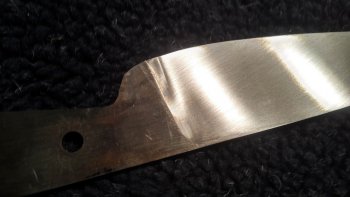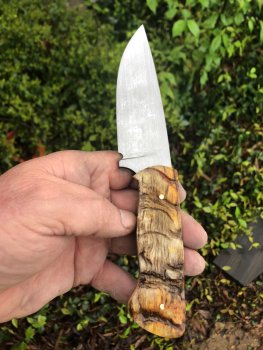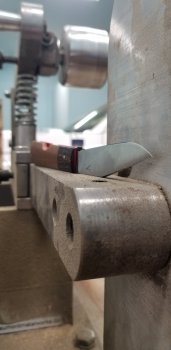You are using an out of date browser. It may not display this or other websites correctly.
You should upgrade or use an alternative browser.
You should upgrade or use an alternative browser.
What's going on in your shop?
- Thread starter Justin Presson
- Start date
That is super nice work. Is engraving actually enjoyable? It fascinates me, but I see videos of guys staring into a microscope for hours on end and I'm wondering if it is relaxing, or tedium. Obviously the finished product is amazing and that has to be gratifying.
I find it amazingly enjoyable. It is a competition with yourself on every single stroke. The microscope blocks everything out and your field of view is at most 1” square. It takes a very small footprint which is nice. I use a small desk in my office.
Feedback is instant. You cut the line correctly or you didn’t. Fixing a mistake(s) on a knife is common. I’ve never had one go together with out an issue. Mistakes on an engraving are nearly impossible to cover up. At least to the experienced eye. It really keeps you on your toes.
I have had a full engraving set up (Lindsay Classic airgraver, Oman scope, Silentaire compressor) for ten years and have dabbled with it on and off. It was time to set everything else aside and put the time in to advance beyond scratches. I have spent the last two days working on trying to get a running wheat border that doesn’t look like a 6 year old did it. I have two more days to go I think. THAT is part of what makes it cool for me. Pay your dues and see progress. I like that. It’s really easy to engrave. It’s really hard to get to a skill level that looks good.
John Wilson
Well-Known Member
I find it amazingly enjoyable. It is a competition with yourself on every single stroke. The microscope blocks everything out and your field of view is at most 1” square. It takes a very small footprint which is nice. I use a small desk in my office.
Feedback is instant. You cut the line correctly or you didn’t. Fixing a mistake(s) on a knife is common. I’ve never had one go together with out an issue. Mistakes on an engraving are nearly impossible to cover up. At least to the experienced eye. It really keeps you on your toes.
I have had a full engraving set up (Lindsay Classic airgraver, Oman scope, Silentaire compressor) for ten years and have dabbled with it on and off. It was time to set everything else aside and put the time in to advance beyond scratches. I have spent the last two days working on trying to get a running wheat border that doesn’t look like a 6 year old did it. I have two more days to go I think. THAT is part of what makes it cool for me. Pay your dues and see progress. I like that. It’s really easy to engrave. It’s really hard to get to a skill level that looks good.
That sounds like a very good skillset to have. There are days when you don’t want to get hot and nasty, and having something productive to do in the clean and quiet would be nice. It’s also an attractive option when the day comes that making knives might be too physically demanding.
Aside from that, I like the fact that it’s a skill which broadens your horizons beyond knives. It would be great having a gig where people send you work like guns, buckles, etc.
Justin Presson
Well-Known Member
Dang!
I got bit by a 60 grit belt today, stay safe!
Sean Jones
Well-Known Member
I find it amazingly enjoyable. It is a competition with yourself on every single stroke. The microscope blocks everything out and your field of view is at most 1” square. It takes a very small footprint which is nice. I use a small desk in my office.
Feedback is instant. You cut the line correctly or you didn’t. Fixing a mistake(s) on a knife is common. I’ve never had one go together with out an issue. Mistakes on an engraving are nearly impossible to cover up. At least to the experienced eye. It really keeps you on your toes.
I have had a full engraving set up (Lindsay Classic airgraver, Oman scope, Silentaire compressor) for ten years and have dabbled with it on and off. It was time to set everything else aside and put the time in to advance beyond scratches. I have spent the last two days working on trying to get a running wheat border that doesn’t look like a 6 year old did it. I have two more days to go I think. THAT is part of what makes it cool for me. Pay your dues and see progress. I like that. It’s really easy to engrave. It’s really hard to get to a skill level that looks good.
So Boss, just out of curiousity, what do you think the learning curve in terms of time would be for someone starting from scratch whose never done any engraving before?
Sean Jones
Well-Known Member
EdCaffreyMS
"The Montana Bladesmith"
Areas like that are why I designed my hand sanding "sticks" in the shape of a sharp triangle. I cut my sandpaper into strips, wrap tightly around the sanding stick, and when it comes to those tight areas, just slight tilt the sanding stick to get into those areas.
Here are examples of the ones we sell on KnifeMakerTraining.com, but it's so simple you can just look at it, and take a bit of time to grind one out....I'd recommend using aluminum. Before Tim found the right plastic formula to 3D print them, I tried micarta, G10 (these would chips on the sharp edges after just a bit of use, and cause big scratches when sanding), then I tried steel, but it tended to rip through the sandpaper and gouge what you're sanding on. Aluminum doesn't chip, won't scratch the steel you're sanding on, and is easy to build. We started offering the sanding sticks after many students who came for classes would ask if they could buy my sanding stick!


Here are examples of the ones we sell on KnifeMakerTraining.com, but it's so simple you can just look at it, and take a bit of time to grind one out....I'd recommend using aluminum. Before Tim found the right plastic formula to 3D print them, I tried micarta, G10 (these would chips on the sharp edges after just a bit of use, and cause big scratches when sanding), then I tried steel, but it tended to rip through the sandpaper and gouge what you're sanding on. Aluminum doesn't chip, won't scratch the steel you're sanding on, and is easy to build. We started offering the sanding sticks after many students who came for classes would ask if they could buy my sanding stick!


Sean Jones
Well-Known Member
Thanks VonGruff and Ed. Ed, I will be buying one of your sanding sticks.
Hand sanding for me is part therapy and part madness. So the more tricks I have to do it is always better.
VonGruff I'll try your method until I get one of Ed's sticks in.
Hand sanding for me is part therapy and part madness. So the more tricks I have to do it is always better.
VonGruff I'll try your method until I get one of Ed's sticks in.
Randy Lucius
Well-Known Member
I have one of Ed's sanding sticks and they are awesome!! Allows you to get into the plunge really well. If I wear this one out I'll probably get another.Areas like that are why I designed my hand sanding "sticks" in the shape of a sharp triangle. I cut my sandpaper into strips, wrap tightly around the sanding stick, and when it comes to those tight areas, just slight tilt the sanding stick to get into those areas.
Here are examples of the ones we sell on KnifeMakerTraining.com, but it's so simple you can just look at it, and take a bit of time to grind one out....I'd recommend using aluminum. Before Tim found the right plastic formula to 3D print them, I tried micarta, G10 (these would chips on the sharp edges after just a bit of use, and cause big scratches when sanding), then I tried steel, but it tended to rip through the sandpaper and gouge what you're sanding on. Aluminum doesn't chip, won't scratch the steel you're sanding on, and is easy to build. We started offering the sanding sticks after many students who came for classes would ask if they could buy my sanding stick!


So Boss, just out of curiousity, what do you think the learning curve in terms of time would be for someone starting from scratch whose never done any engraving before?
About the same as learning to make a knife. After a couple hundred hours - which isn't that much. You should be able to engrave something that is passable. Keep in mind there are several types of engraving: traditional scroll which I am working on, Western Bright Cut (think cowboy buckles), English scroll (zillions of tiny scrolls typically on firearms), In lay (which can be used in all of them), Deep relief, Sculpted, Bulino (mind boggling photo realistic), German (a variation of English) and a couple more. Certainly if you learn one, most of those skills transfer but it's not automatic. Each discipline has it's own "rules" and learning curve.
One problem is that engraving is not documented nearly as well as knife making or other crafts. There are hundreds, probably thousands of videos on Youtube on knife making. There are *maybe* dozens of tutorial videos showing how to engrave and most of those are not that helpful.
That is the physical process of engraving. Sketching/designing aesthetically pleasing drawings to engrave is another discipline and I find it quite a bit harder. You notice I haven't posted any of my sketches because they suck. I spend 2 to 4 hours a week working on sketches. This isn't all bad, I do it in the evening with the TV on that I like to ignore.
John mentioned it would be good to be able to "fall back" to something when knife making winds down in your life and this is one of the reasons I took it up. I expect this skill to give me something to do until I'm done working with my hands - which I hope never happens. I have no intentions of taking engraving commissions. This is purely for me to make fancier knives.
Sean Jones
Well-Known Member
About the same as learning to make a knife. After a couple hundred hours - which isn't that much. You should be able to engrave something that is passable. Keep in mind there are several types of engraving: traditional scroll which I am working on, Western Bright Cut (think cowboy buckles), English scroll (zillions of tiny scrolls typically on firearms), In lay (which can be used in all of them), Deep relief, Sculpted, Bulino (mind boggling photo realistic), German (a variation of English) and a couple more. Certainly if you learn one, most of those skills transfer but it's not automatic. Each discipline has it's own "rules" and learning curve.
One problem is that engraving is not documented nearly as well as knife making or other crafts. There are hundreds, probably thousands of videos on Youtube on knife making. There are *maybe* dozens of tutorial videos showing how to engrave and most of those are not that helpful.
That is the physical process of engraving. Sketching/designing aesthetically pleasing drawings to engrave is another discipline and I find it quite a bit harder. You notice I haven't posted any of my sketches because they suck. I spend 2 to 4 hours a week working on sketches. This isn't all bad, I do it in the evening with the TV on that I like to ignore.
John mentioned it would be good to be able to "fall back" to something when knife making winds down in your life and this is one of the reasons I took it up. I expect this skill to give me something to do until I'm done working with my hands - which I hope never happens. I have no intentions of taking engraving commissions. This is purely for me to make fancier knives.
Thanks for the comprehensive reply Tracy. That is very helpful information. Gives me a lot to think on. It's a skill I would like to learn but it looks like I'd better concentrate on making good knives first.
Randy Lucius
Well-Known Member
Sean Jones
Well-Known Member
Looking good Lucius! Very nice
Chris Railey
Well-Known Member
I really dig those scales
Stang Bladeworks
KNIFE MAKER
Daniel Macina
Well-Known Member
Y’all are so good! love the quality of work on here!
Sean Jones
Well-Known Member
That's a real looker Stang. Very nice!
Stang Bladeworks
KNIFE MAKER
Thanks. Slowly I am starting to figure them out.That's a real looker Stang. Very nice!
Thanks VonGruff and Ed. Ed, I will be buying one of your sanding sticks.
Ed Caffery's sanding sticks get my vote too. I forgot I had one, and was just working on some scratches like that. I was trying different ways to get them out without hitting the spine (again) and I remembered I had one. It helped me get them out pretty quick and it was easy to put the sandpaper right where I wanted it.





